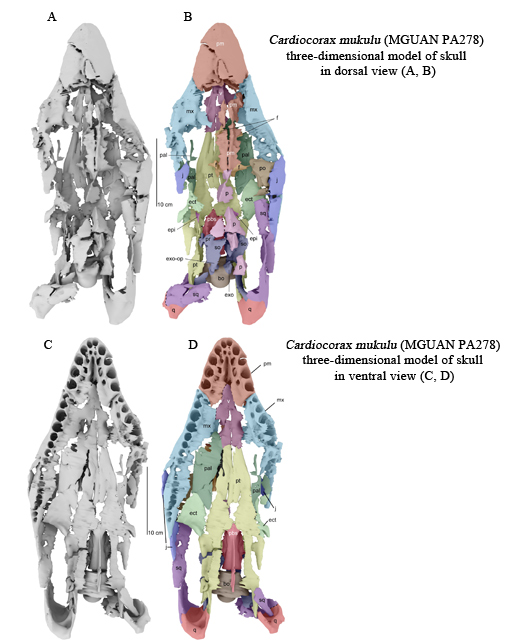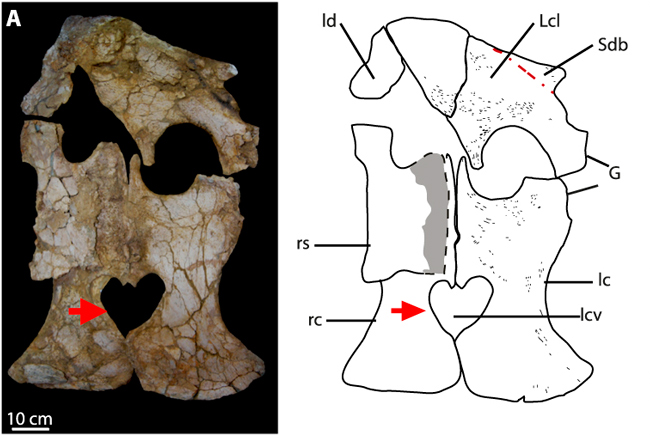Researchers writing in the on-line, open-access journal PLOS One have described the most complete plesiosaur skull found to date from sub-Saharan Africa. The skull and post cranial fossil material reported upon comes from the Upper Cretaceous Mocuio Formation exposures located at Bentiaba in the Namibe Province of Angola.
The fossils represent another specimen of the elasmosaurid Cardiocorax (C. mukulu) one of just six valid plesiosaurian taxa known from the whole of Africa. This plesiosaur swam in a shallow, tropical sea and the fossils are around 71.5 million years old.

Cardiocorax mukulu
The specimen was found in sandstone deposits, stratigraphically just 3 metres above where the holotype material for this taxon was found. The researchers who studied the fossils, which included Octávio Mateus (Museu da Lourinhã, Portugal) and lead author Miguel Marx from the Southern Methodist University (Dallas, Texas), concluded that the fossils represented C. mukulu as the overlapping skeletal material of this specimen – MGUAN PA278 with that of the holotype were virtually identical.

Picture credit: Everything Dinosaur
This elasmosaurid had been originally named and described back in 2015. The genus name comes from the Greek “kardia” which means heart and coracoid, a paired bone that forms part of the shoulder in most vertebrates. This is a reference to the unique heart-shaped fenestra (hole) which occurs between the coracoid bones, a characteristic that is unique to this genus. The specific or trivial name comes from the local Angolan Bantu dialect and means “ancestor).

High Resolution CT Scans Reveal Details of Plesiosaur Skull
The exquisite, three-dimensional preservation of the skull material provided the scientists with an opportunity to examine in close detail the morphology of the skull. The delicate fossil could have been damaged during further preparation, so the specimen was subjected to high resolution CT scans at the University of Texas High-Resolution X-ray CT Facility this permitted the anatomy of the skull to be revealed.
The holotype fossils, which were used to name and describe this elasmosaurid back in 2015 lacked skull bones. The discovery of an almost complete, three-dimensional skull of Cardiocorax enabled the research team to conduct an elaborate series of phylogenetic assessments to assess where within the Plesiosauria Cardiocorax should be placed.
Most of these analyses suggest an early-branching or intermediate position for Cardiocorax mukulu within the Elasmosauridae family. Elasmosaurines have elongated neck bones (cervical vertebrae), this anatomical characteristic is absent in Cardiocorax mukulu which suggests that it was a relic of an older, less derived lineage of elasmosaurids. These results indicate that several different types of elasmosaurid persisted into the Maastrichtian faunal stage of the Cretaceous.
The scientific paper: “The cranial anatomy and relationships of Cardiocorax mukulu (Plesiosauria: Elasmosauridae) from Bentiaba, Angola” by Miguel P. Marx, Octávio Mateus, Michael J. Polcyn, Anne S. Schulp, A. Olímpio Gonçalves and Louis L. Jacobs published in PLOS One.
The Everything Dinosaur website: Prehistoric Animal Figures and Toys.






Leave A Comment